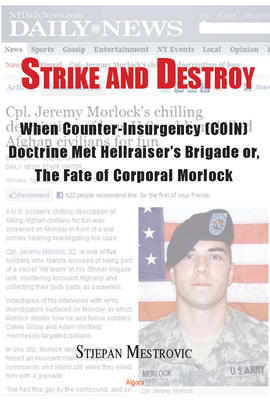
Sound Bite
In a "spontaneous-combustion theory" of war crimes, Jeremy Morlock and 4 other soldiers were charged with having murdered 3 Afghans, as if they just spontaneously did monstrous things. But in an extraordinary court-martial related to the Maywand District killings in Afghanistan in 2010, the Defense showed that in fact the atrocities originated in a failure of leadership and a dysfunctional brigade climate. Dr. Stjepan Mestrovic, a professional sociologist who has testified in the trial, explains.
About the Author
Prof. Mestrovic has testified as an expert witness at The Hague and at Fort Hood. He is the author of 17 books (two with Algora) and numerous articles. His particular areas of interest include Abu Ghraib, culture, and race and ethnic studies in the Balkans. He holds three degrees from Harvard University and has been teaching at Texas A&M since 1991.
|
|
About the Book
How could the 'Maywand District killings'Â (or the 'kill team'Â war crimes) have happened? Jeremy Morlock was convicted of premeditated murder, but numerous other 'questionable kills'Â in his brigade, committed by other soldiers in other units...
How could the 'Maywand District killings'Â (or the 'kill team'Â war crimes) have happened? Jeremy Morlock was convicted of premeditated murder, but numerous other 'questionable kills'Â in his brigade, committed by other soldiers in other units in 2010, were never investigated.
The brigade commander went by the name Hellraiser, and an internal army investigation revealed that the officers of the brigade were hopelessly confused as to their mission. No one knew if they should obey the chain of command and "do COIN," in other words, "sit down for tea with the village elders'Â, or carry out Hellraiser's and the army's traditional counter-guerrilla doctrine. Hellraiser's refusal to carry out COIN doctrine led to complete social dysfunction in the brigade. Normal army standards of discipline, drug testing, group cohesion, mentoring, counseling, among other standards, were abandoned.
Prof. Mestrovic connects the social dysfunction in Hellraiser's brigade with Morlock's crime. He shows that COIN doctrine was treated as a joke in the brigade while a 'Strike and Destroy'Â mentality was dominant.
This inside account relies upon an internal army investigation into the command climate of Hellraiser's brigade, conducted by Brigadier General Stephen Twitty, along with court-martial transcripts, and direct interviews. This book analyzes one war crime incident as an example of the general failure, or refusal, to implement COIN doctrine in Afghanistan.
|
|
Pages 248
Year: 2012
BISAC: LAW068000
BISAC: HIS027190
Soft Cover
ISBN: 978-0-87586-909-4
Hard Cover
ISBN: 978-0-87586-910-0
Price: USD 32.95
eBook
ISBN: 978-0-87586-911-7
|













